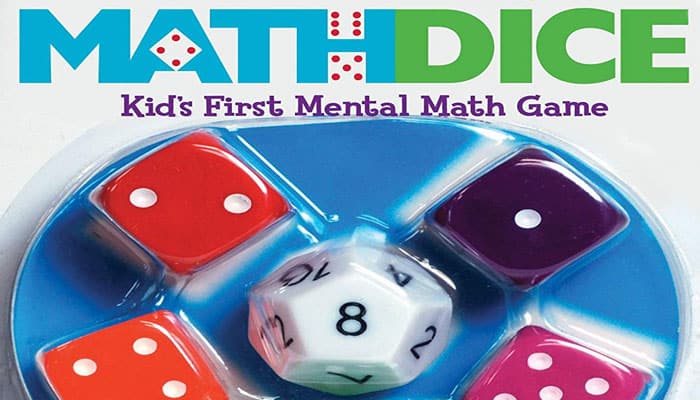
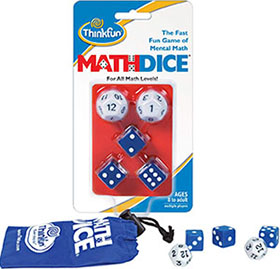
Components
- Two 12-sided Dice
- Three 6-sided Dice
- Travel Bag
- Instruction Booklet
Object of the Game
Use your math skills to combine three numbers to match, or come closest to, the Target Number.

Game Play
Start by rolling the two 12-sided Target Dice. Multiply them together to establish a Target Number. In the example below, when you roll a 7 and a 4 the Target Number is 28.

Then roll the three 6-sided Scoring Dice to establish three Scoring Numbers. In the example below, a 5, 2, and 3 are your Scoring Numbers.

Using the Scoring Numbers, create an equation to calculate the closest number possible to the Target Number. Your answer could be above the Target Number, below the Target Number, or hit the Target Number exactly, depending on the numbers rolled and what you do with them.
To create your equation, use each Scoring Number once and only once, along with any combination of the following operations: addition, subtraction, multiplication, division, powers, and roots. You may use the Scoring Numbers and operators in any order.
In our example, two players might shout out the following...
(Remember, the Target Number is 28 and the Scoring Numbers are 5, 2, and 3).
- Player 1 shouts, "25!" (2 + 3) x 5
- Player 2 shouts, "30!" 2 x 3 x 5
- Player 1 shouts, "29!" 25 - 3
- Player 2 shouts, "27!" (5 - 2)3
- Player 1 shouts, "28!" 52 + 3, hits the Target Number exactly, and wins the point.
Note how each number is used once and only once in each equation. This rule is especially important to understand when the numbers are used as powers. The player who hit 28 used the "2" to raise the 5 to the second power; the player who reached 27 used the "3" to raise (5 - 2) to the third power.
The fun and flexibility of this game are in combining the three Scoring Numbers in the most creative ways to get the best answer.


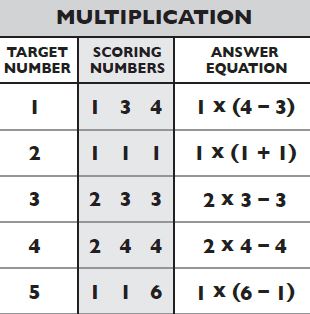
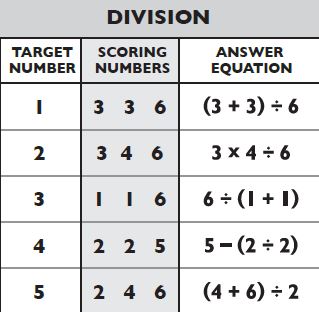
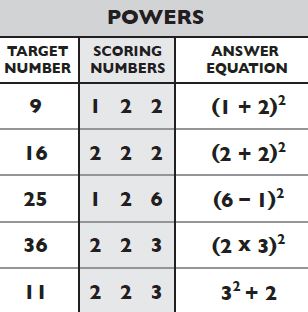
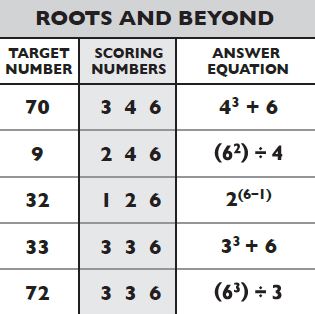

Scoring
Your goal is to beat your opponent by getting closer to the Target Number, faster. Once you have an answer you are satisfied with, call it out. The first player to call out an answer, claims that number.
If the Target Number hasn't been reached, other players then have 15 seconds to respond with a new answer that is closer to the Target Number. (The player with the current best answer must remain silent while the other players try for a better answer).
This play continues, with an additional 15 seconds added after each improvement, until one player hits the Target Number exactly, the other players forfeit the point, or the time limit for calculating is reached.
The player with the closest number at the end of the point must state the equation he or she used to reach the answer. If it is correct, the point is won. If incorrect, the player with the next closest answer must state his or her equation, and gets the point if it is correct.
End of the Game
The first player to win four points wins the game.
Note: If you are playing competitively, MathDice is a "mental math" game... pencil, paper, or a calculator are not allowed.

Simpler Versions of Play
MathDice is a fun, educational game. The rules above describe competitive play. For your enjoyment, please feel free to relax the rules in any way that suits your group of players.
To lower the average difficulty of the calculations, reduce the range of the Target Numbers. To do this, you may:
Roll only one 12-sided die to establish a Target Number in the range between 1 and 12. This version makes a good game for players who are more confident with addition and subtraction skills, and just starting to get a mastery of multiplication.
Roll two 12-sided dice, and add the two numbers together, to establish a Target Number in the range between 2 and 24. This version makes a good game for players who have confidence in their adding/ subtracting/multiplying skills, but are not yet comfortable with more advanced operations.
For a more cooperative environment, choose from the following:
- Everyone who can match the best answer given on a turn, gets a point for that turn.
- Relax time constraints.
- Allow use of pencil and paper or calculators.
- Work together to find as many answers as you can that are close to the Target Number.
- Have fun exploring the numbers and their patterns!
Mathdice and the Flexibility of Numbers
Numbers are incredible. As you play MathDice and your skills improve, you will come to discover patterns and relationships that will astound you. Really!
To get you started down this path, we've developed eight Practice Tables that you can use to hone your skills. The first five tables each focus on a different operation, and the final three WOW! Tables show examples with multiple ways of reaching the Target Number.
Once you work your way through these stretching drills, you're ready for action!
Continue Reading


